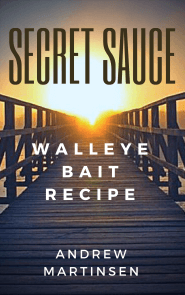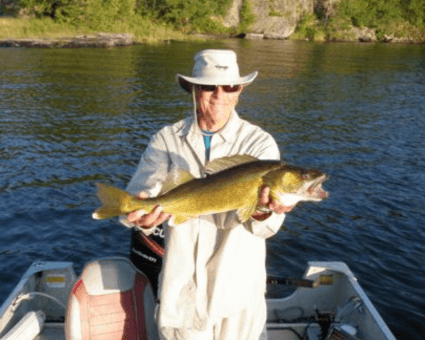Sign up for FREE Walleye Fishing Tips
• Sign up for a Complimentary Copy of
My Report Called "Secret Sauce: The Bait Recipe for More and Bigger Walleyes."

• PLUS, you also get a complimentary subscription to my exclusive email publication, jam-packed with loads of "under-the-radar"
walleye fishing tips that can help you to catch walleyes fast!

Privacy Guarantee: I solemnly pledge never to spam you or sell your email address to anyone, and of course you can unsubscribe at any time.
Contour Trolling
|
Fishfinder Tips
|
Jigging Tips
|
Crankbait Tips
|
Trophy Walleyes
|
More Reports...

Andrew Martinsen's Walleye Fishing Update
Crawler Harness Creations
How to Build Your Own Harness
A crawler harness is not hard to assemble, but it will take some practice to perfect it. To make the basic harness, you will need: monofilament line ranging anywhere from 12 to 30 lb, long shank or live bait hook, six 6mm beads, a spinner blade, and a #2 or #4 folded clevis for the spinner blade. These basic supplies can be found in most stores that sell tackle or online.
To assemble the rig, start with a 5-foot piece of line cut from the reel. Hold the hook in one hand while keeping the eyelet toward the other hand. Thread one to two inches of line through the eyelet and pinch it firmly to the shank, keeping your hand closer to the hook.
Take the remaining line and begin wrapping it down the shank, going toward the hook. Keep it tight as possible as you wrap going around six to eight times before pressing the knot with a finger on the hand holding the hook. Thread the line again through the eyelet, but go the opposite way you started with. If you threaded the hook from right to left, you will need to go left to right in order to secure the knot. Pull the line to tighten the knot. This part takes practice and you may need to try several times before you have a satisfactory knot.
Once you have a knot you're happy with, you can add five beads to the line. Beads add vibration to the harness and there are many choices to consider. Most anglers use #6 plastic beads, but you can opt for glass beads. They are more expensive, but are heavier and louder. Some beads have facet sides, which reflect more light in the water. Orange and red are the most common colors, but there are other colors that may work better depending on the waters you are fishing.
The next item to add to the line is the spinner blade. Before putting the blade on the line, place the clevis through the hole in the spinner with both holes on the conclave side of the blade. The clevis will keep the blade from cutting through the line. Thread the line up through both of the clevis holes, keeping the cupped side of the blade toward the line.
There are endless possibilities when it comes to choosing a spinning blade. In general, bigger blades spin slower and vibrate louder while smaller ones spin easier and produce a higher frequency. A #4 Colorado blade is a good one to start with. Don't be afraid to experiment with other combinations. Adaptability is what makes this rig great.
Add one last bead before adding the final knot. Double over the last two inches of your line and tie it with an overhand knot, leaving a ? to 1-inch diameter loop. Trim off the remaining line, but leave about ? inch extra past the knot for future tightening.
Once you have mastered the basics of building a crawler harness, the customization can begin. There are many ways to change the rig to fit your needs. Learning to rig up your own walleye crawler harness will open a whole new world of possibilities.
You're About to Discover Intense Walleye Fishing Techniques that Can Increase Your Walleye Catch Count When You Hit the Water
Inside My Exclusive Email Publication, You'll Discover...
• An underground Secret Sauce bait recipe for catching walleye.
• Under-the-radar walleye fishing tips that can help you to catch walleyes fast!
• How to create an irresistible attraction to
your offering that can make even satisfied fish that aren't hungry snap at it.
• How to catch more and bigger walleyes using the stuff you've already got in your tackle box.
• And much, much more!

Directions: It's easy. Simply fill in
your name and email address and your first of many FREE
underground walleye
fishing reports will be sent to your email box immediately. Go ahead right now...

"Andrew,

25 Inch Walleye Caught at Lake of the Woods
Walleye Fishing Secrets Student Shares an Awesome Catch

Here's a 25 inch walleye caught at Lake of the Woods, Ontario. The
picture is a great memento for me.
I caught it drifting. We caught it amongst some smaller ones that ended up
on the dinner table.
Your advice was helpful in making my trip successful. Thank you!"
- Russell K.
Join thousands of anglers throughout North America who are catching more and bigger walleyes from shore or on a boat in lakes, rivers and streams:
Join thousands of anglers throughout North America who are catching more and bigger walleyes from shore or on a boat in lakes, rivers and streams:

If you've been wanting to get more satisfaction from your
walleye fishing outings, sign up to my
FREE
walleye fishing catching email publication!
Great Fishin' to You! (Always),
Sincerely,
Andrew Martinsen
WalleyeFishingSecrets.com
WalleyeFishingSecrets.com


